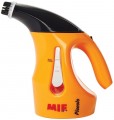Power consumption
Rated power consumed by the device during operation. Usually, it is indicated by the maximum power consumption when used in normal mode, without abnormal situations.
In general, this parameter is secondary when choosing: manufacturers select power in such a way as to provide the necessary indicators of performance, pressure, etc. However, some practical points are also associated with power. So, with the same performance (see "Steam intensity"), a more powerful device will spend less time heating water and generating steam; it can also be provided with a more capacious boiler (see "Water boiler volume"), which is useful for long-term continuous operation. On the other hand, such devices turn out to be more expensive, and often also heavier and larger than relatively “weak” steamers, and besides, they load the mains more.
The second point related to power is just the calculations of the load on the wiring and various electrical equipment (protective automation, AVRs, generators, etc.).
Water boiler volume
The volume of the water boiler used in the steamer.
First of all, we emphasize that you should not confuse the boiler and the water tank (see below). A boiler is a reservoir in which water is heated to form steam; in some models, such a reservoir is supplemented by a cold water tank, in others, the entire supply of water is located directly in the boiler. Accordingly, the meaning of this parameter depends on whether the device has an additional tank or not.
If there is a separate tank in the design, then the volume of the boiler is rather a secondary indicator: it is selected in such a way as to provide the claimed performance (and it is worth focus on these specifications when choosing). If there is no tank, then the volume of the boiler directly depends on how much water will fit in the device and how long it can work on one such refill. At the same time, an increase in volume allows to work longer without refueling, but it affects the dimensions, weight, price, and often also the power consumption of the device (a more capacious boiler requires a more powerful heater).
Water tank volume
The volume of the tank for the water supply provided in the device.
We emphasize that this indicator should not be confused with the volume of the boiler (see above): in this case, we are talking about a reservoir with a supply of cold water, from which such water enters the boiler for heating. Not every steam cleaner is equipped with such a reservoir.
Detachable water tank
Device has a water tank with a
detachable design.
The detachable design makes refueling much easier. In particular, it allows to fill the tank under the tap, while with a non-detachable tank, this option is often not available. And some models with this feature can be refueled during operation, without turning off the heating and without relieving pressure in the boiler (although it still will be necessary to clarify this possibility separately). In addition, a detachable tank is much easier to clean or wash than a non-detachable one.
Steam flow
Steam flow provided by the device. For models with power and/or humidity adjustment, this item indicates the maximum possible value.
When choosing according to this indicator, it should be borne in mind that the steam flow characterizes only the amount of water vapor produced by the device per minute. The intensity of the impact of this steam on the treated surface/product can be different, first of all, it depends on the working pressure. Therefore, only devices with similar pressure indicators can be directly compared by this indicator. When making these comparisons, it's worth assuming that higher steam flow allows to handle a large amount of work faster, but requires more powerful heaters and larger tanks – which, in turn, affects the dimensions, weight and price of the entire steamer.
Continuous operation time
Approximate time that the device is able to operate without breaks. This parameter is determined primarily by the performance and capacity of the boiler/tank: when the water supply is exhausted, the work will have to pause to replenish the stock. At the same time, for models with humidity and/or power adjustment, both the average time of continuous operation (at a certain standard mode), and the longest (at minimum intensity) or the shortest (at maximum) can be indicated; these details should be clarified separately.
It is worth saying that some models allow refueling with water right in the process of operation, but it also does not hurt to clarify this possibility separately.
Heating time
Heating time until steam is generated. The duration of the heating process directly depends on the power of the device and the volume of the water tank.
We also note that in some situations the actual heating time may be less than the declared one. For example, if the main tank (boiler) is not completely filled, and the design does not provide an additional tank for cold water. For a full guarantee, you should still focus on the value directly stated in the specifications.

